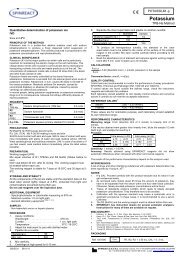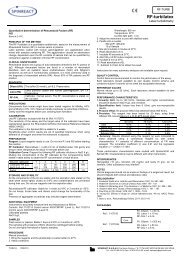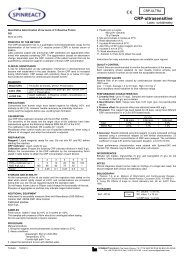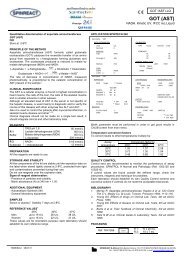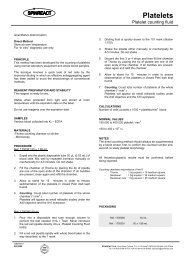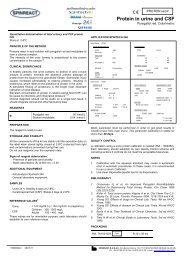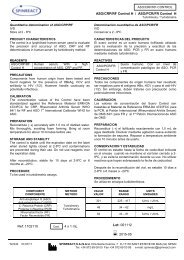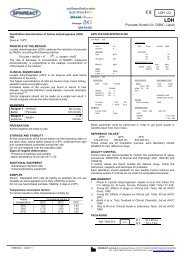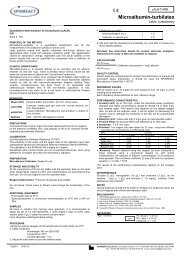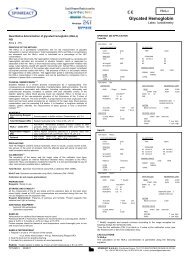Fecal Occult Blood
Fecal Occult Blood - Spinreact
Fecal Occult Blood - Spinreact
You also want an ePaper? Increase the reach of your titles
YUMPU automatically turns print PDFs into web optimized ePapers that Google loves.
SPIN – F.O.B.<br />
<strong>Fecal</strong> <strong>Occult</strong> <strong>Blood</strong><br />
One step - Cassette<br />
One Step Immunochromatographic assay for the qualitative detection of<br />
<strong>Fecal</strong> Ocult <strong>Blood</strong><br />
IVD<br />
Store at 2-30ºC<br />
INTENDED USE<br />
This <strong>Fecal</strong> <strong>Occult</strong> <strong>Blood</strong> (FOB) Rapid Test is an immunochemical device intended for the<br />
qualitative detection of human hemoglobin in stool samples by laboratories or physicians<br />
offices.<br />
It is for health care professional use only.<br />
This assay provides only a preliminary result. Clinical consideration and professional<br />
judgment must be applied.<br />
CLINICAL SIGNIFICANCE<br />
Screening with fecal occult blood tests is based on the concept that gastrointestinal bleeding is found<br />
in important gastrointestinal disorders, such as: diverticulitis, colitis, polyps, and colorectal cancer.<br />
Colorectal cancer is a leading cause of illness and death in Western world.<br />
When gastrointestinal blood is lost, the stool will contain a combination of intact or nearly intact<br />
hemoglobin, intact heme, and heme-derived porphyrins in amounts that depend on the site and<br />
amount of bleeding and the transit time through the gut.<br />
At this moment the commercially available types of assays for FOB testing are:<br />
1. The Guaiac test is widely available but lacks high accuracy. Guaiac is a naturally occurring<br />
phenolic compound that can be oxidized to quinone by hydrogen peroxidases with a detectable color<br />
change. The sensitivity and specificity of Guaiac tests are much lower than those of Hemoporphyrin<br />
tests and Immunochemical assays. The low accuracy of the Guaiac Dye method is related to dietary<br />
peroxidases, including hemoglobin and myoglobin from meat and uncooked fruits and vegetables.<br />
Non-cancerous gastrointestinal tract bleeding and iron intake may also cause false positive results<br />
from Guaiac test. 2<br />
2. The Hemoporphyrin test is not affected by dietary peroxidases, but false-positive results can<br />
occur in patients with upper gastrointestinal bleeding disorders such as gastric or duodenal ulcers<br />
because porphyrins are not broken down by stomach acids. 2<br />
3. Immunochemical tests detect intact or nearly intact human hemoglobin, being a very specific<br />
technique for detecting loss of blood from the lower intestine, because blood from lower sites is less<br />
degraded during transit. The results of immunochemical FOB rapid tests are not affected by dietary<br />
peroxidases, animal blood and ascorbic acid.<br />
PRINCIPLE OF THE METHOD<br />
This assay is a one-step lateral flow chromatographic immunoassay. Once dispensed into the<br />
sample well of the device, the sample is allowed to react with the coloured conjugate (anti-human<br />
hemoglobin mouse monoclonal antibodies-red microspheres) which was pre-dried on the test. The<br />
mixture then moves upward on the membrane by capillary action.<br />
In the case of a positive result, the specific antibodies present on the membrane will capture the<br />
coloured conjugate. The mixture continues moving across the membrane to the immobilized antibody<br />
placed in the control band region, where a GREEN coloured band should always appears.<br />
REAGENTS AND MATERIAL SUPPLIED<br />
5 / 20 / 50 test devices, each sealed in a pouch with a desiccant.<br />
5 / 20 / 50 Stool collection tubes, each filled with sample extraction diluent<br />
MATERIAL REQUIRED BUT NOT PROVIDED<br />
Timer<br />
Specimen collection container<br />
Disposable gloves<br />
STORAGE AND STABILITY<br />
The test device is stable when stored in a controlled environment at 2-30 C (35.6-86°F) until<br />
the expiration date printed on the label. Do not freeze or expose the kit components to<br />
temperatures over 30 C (86°F).<br />
PRECAUTION<br />
1. This kit is for professional in-vitro diagnostic use only.<br />
2. Do not use expired kit components.<br />
3. Treat all specimens and used assay materials as if they are infectious.<br />
4. Dispose of all used test components in a biohazard container, after testing.<br />
SPECIMEN COLLECTION<br />
Stool samples should be collected in clean containers and the assay should be done right<br />
after collection.<br />
Precautions: Patients should not collect samples during their menstrual period, if they have<br />
bleeding haemorrhoids, blood in urine, or if they have strained during bowel movement.<br />
The samples can be stored in the refrigerator (2-4ºc) for 1-2 days prior to testing. For longer<br />
storage, maximum 1 year, the specimen must be kept frozen at –20ºc. In this case, the<br />
sample will be totally thawed, and brought to room temperature before testing.<br />
1. Unscrew the cap (with the attached sampler) of the collection tube.<br />
2. Randomly pierce the fecal specimen with the threaded end of the sampler in different<br />
sites. Wipe excess feces off the shaft and outer grooves.<br />
3. Insert sampler in the collection tube and firmly tighten the cap.<br />
4. Shake the tube well to mix the specimen and the extraction buffer.<br />
Stool sample<br />
Stool collection<br />
Tube (1) (2)<br />
ASSAY PROCEDURE<br />
1. Refrigerated specimens or other materials, including the test cassette, must be<br />
equilibrated to room temperature (15-30ºC) before testing. Use a separate stool<br />
collection tube and device for each sample or control.<br />
2. Proceed to shake the stool collection tube in order to assure good sample dispersion.<br />
Cut the end of the top (3).<br />
3. Remove the test cassette from its pouch and place it on a flat surface. Do not open<br />
pouches until ready to perform the assay. Label the device with appropriate<br />
identification.<br />
4. Squeezing the collection tube, dispense 5 drops or 150 µL of the extraction solution in<br />
into the sample well ("S") (4).<br />
5. Read the result at 5 minutes. IMPORTANT: Do not read the test results after ten (10) minutes.<br />
INTERPRETATION OF RESULTS<br />
NEGATIVE POSITIVE INVALID<br />
Negative:<br />
If only the green line appears across the central window in the site marked with the letter C (control<br />
line).<br />
Positive:<br />
If both green-line and red-line (test line) are present. Note:The intensity of the RED coloured band in<br />
the result line region (T) will vary depending on the concentration of human hemoglobin in the<br />
specimen. However, neither the quantitative value, nor the rate of increase in hemoglobin can be<br />
determined by this qualitative test.<br />
Invalid: a total absence of the control coloured band (GREEN) regardless the appearance or not of<br />
the result line (RED). Insufficient specimen volume, incorrect procedural techniques or deterioration<br />
of the reagents are the most likely reasons for control line failure. Review the procedure and repeat<br />
the tests with a new test. If the problem persists, discontinue using the test kit and contact you local<br />
distributor.<br />
QUALITY CONTROL<br />
Internal Quality Control<br />
This device contains a built-in control feature, the Control line (C-line). The presence of this C-line<br />
indicates 1) that sufficient volume is added, 2) that proper flow is obtained and 3) as an internal<br />
control for the reagents.<br />
External Quality Control<br />
Operators should always follow the appropriate federal, state, and local guidelines concerning the<br />
running of external quality controls, including positive and negative, to assure the proper<br />
performance of the device.<br />
LIMITATIONS OF THE PROCEDURE<br />
1. The test must be carried out within 2 hours of opening the sealed bag.<br />
2. An excess of stool sample could cause wrong results (brown bands appear or absence of the<br />
control coloured band).<br />
3. The intensity of the lines may vary from very strong at high hemoglobin concentrations to faint<br />
when the hemoglobin concentration is close to the sensitivity limit of the test.<br />
4. This test may be less sensitive for detecting upper gastrointestinal bleeding because blood<br />
degrades as it passes through the gastrointestinal track.<br />
5. Results cannot be considered conclusive evidence of the presence or absence of gastrointestinal<br />
bleeding or pathology.<br />
A positive result should be followed up with additional diagnostic procedures to determine the exact<br />
cause and source of the occult blood in the feces.<br />
False negative results can be obtained even when a gastrointestinal disorder is present.<br />
a. For example, some polyps and colorectal cancers may bleed intermittently or not at all<br />
during certain stages of the disease.<br />
b. Additionally, blood may not be uniformly distributed in stool samples. When occult blood is<br />
not uniformly distributed throughout the bowel movement and the formation of a fecal<br />
sample.<br />
PERFORMANCE CHARACTERISTICS<br />
Sensitivity: A sample containing human hemoglobin at concentration equal to or higher than 50<br />
ng/mL produces a positive result using the SPIN-FOB. In some cases samples containing human<br />
haemoglobin at concentrations less than 50 ng/ml can also be tested as positive.<br />
Different hemoglobin dilutions were tested directly in the extraction buffer or spiked in a negative stool<br />
sample in accordance with the kit instructions. The detection of human hemoglobin with the SPIN-<br />
FOB showed >99% of sensitivity compared with a commercial guaiac assay.<br />
Specificity: The SPIN-FOB Test is specific for human hemoglobin and do not show any cross<br />
reaction with hemoglobin from bovine and pig.<br />
The detection of human haemoglobin with SPIN-FOB Test showed >99% of specificity compared with<br />
a commercial guaiac assay. The use of mouse monoclonal antibodies in the elaboration of the SPIN-<br />
FOB assures high degree of specificity for the detection of human hemoglobin.<br />
REFERENCES<br />
1. Towler BP, Irwig L, Glasziou P, Weller D, Kewenter J. Screening for colorectal cancer using the faecal occult blood<br />
test, Hemoccult. Cochrane Database Syst Rev. 2000;(2): CD001216.<br />
2. Ransohoff DF and Lang CA. Screening for colorectal cancer with the <strong>Fecal</strong> <strong>Occult</strong> <strong>Blood</strong> Test: a background paper.<br />
Ann Intern Med. 1997; 126: 811-822.<br />
3. Ransohoff DF and Lang CA. Suggested technique for Faecal <strong>Occult</strong> <strong>Blood</strong> testing and interpretation in colorectal<br />
cancer screening. Ann Intern Med. 1997; 126: 808-810.<br />
4. Allison JB, Takawa IS, Ransom LJ, Adrian AL. A comparison of fecal occult blood tests for colorectal-cancer<br />
screening. N Engl J Med 1996; 334:155-159.<br />
PACKAGING<br />
GREEN<br />
RED<br />
Ref. 1504010<br />
Ref. 1504011<br />
Ref. 1504012<br />
control region result<br />
(3) (4)<br />
Cont<br />
RED<br />
5 Cards-5 Buffer tubes<br />
20 Cards-20 Buffer tubes<br />
50 Cards-50 Buffer tubes<br />
S<br />
Add 5 drops<br />
OSIS23-I 18/11/11 SPINREACT,S.A./S.A.U. Ctra.Santa Coloma, 7 E-17176 SANT ESTEVE DE BAS (GI) SPAIN<br />
Tel. +34 972 69 08 00 Fax +34 972 69 00 99. e-mail: spinreact@spinreact.com
SPIN – F.O.B.<br />
Sangre Oculta en Heces<br />
One step - Cassette<br />
Ensayo inmunocromatográfico One Step para la determinación cualitativa<br />
de Sangre Oculta en Heces<br />
IVD<br />
Conservar a 2-30ºC<br />
4. Dispensar cinco (5) gotas o 150 µL del líquido de la solución de extracción en la ventana circular<br />
marcada con una flecha o una S en el dispositivo (4).<br />
5. Leer el resultado a los cinco (5) minutos. IMPORTANTE: No leer los resultados pasados los<br />
diez (10) minutos.<br />
USO RECOMENDADO<br />
El sistema empleado en este test es un inmunoensayo en fase sólida para la detección<br />
cualitativa de hemoglobina humana en heces (FOB). Sólo para uso profesional.<br />
El test se usa únicamente para obtener un resultado preliminar. En cualquier caso el<br />
resultado debe ser interpretado por un profesional.<br />
S<br />
Añadir 5 gotas<br />
SIGNIFICADO CLÍNICO<br />
El test resulta útil para la detección de hemorragias intestinales que tienen lugar en un gran número<br />
de desórdenes gastrointestinales: diverticulitis, colitis, pólipos y cáncer colorectal. El cáncer colorectal<br />
es la principal causa de enfermedad y muerte en el mundo occidental.<br />
Cuando se elimina sangre gastrointestinal, las heces contienen una mezcla de hemoglobina no<br />
degradada o poco degradada, grupos hemo, y porfirina hemo-derivada en cantidades que dependen<br />
del lugar, de la cantidad de sangrado y del tiempo de tránsito a través del intestino.<br />
Actualmente se pueden encontrar en el mercado tres tipos de ensayos para el análisis de F.O.B.:<br />
1. El test Guaiac es el más extendido aunque carece de una gran exactitud. El Guaiac es un<br />
compuesto fenólico que puede ser oxidado a quinona, mediante peroxidasas, con un cambio de<br />
color detectable. La sensibilidad y especificidad de este método es inferior a la de los otros tipos. La<br />
baja exactitud de este método está relacionada con las peroxidasas que se encuentran la dieta, como<br />
por ejemplo la hemoglobina y mioglobina de la carne, frutas o vegetales crudos. El tratamiento de<br />
hemorragias gastrointestinales no cancerosas y la ingesta de hierro pueden causar falsos resultados<br />
positivos en el test de Guaiac.<br />
2. El test Hemoporfirina no se ve afectado por las peroxidasas de la dieta, pero se pueden dar<br />
falsos resultados positivos en pacientes con desórdenes gastrointestinales hemorrágicos superiores,<br />
como úlceras duodenales o gástricas, debido a que las porfirinas no son inactivadas por los ácidos<br />
biliares. 2<br />
3. Los tests inmunocromatográficos detectan hemoglobina humana no degradada o casi<br />
intacta, siendo una técnica muy específica para detectar pérdidas de sangre producidas en la parte<br />
final del intestino, ya que la sangre procedente de este lugar sufre menor degradación durante su<br />
tránsito. Los resultados del test inmunocromatográfico no se ven afectados por las peroxidasas<br />
presentes en la dieta, sangre animal o ácido ascórbico.<br />
PRINCIPIO DEL MÉTODO<br />
El SPIN-F.O.B.Test es un inmunoensayo por cromatografía de flujo lateral. La muestra reacciona con<br />
los conjugados coloreados (anticuerpos monoclonales de ratón anti-hemoglobina humanamicroesferas<br />
rojas) previamente secados en el test. Independientemente de que haya presencia o no<br />
de hemoglobina humana, la mezcla de conjugado va avanzando por capilaridad a través de la la<br />
membrana hasta la región de control donde se han inmovilizado anticuerpos y debiendo siempre<br />
aparecer una línea de color VERDE (línea de control). Si el resultado es positivo, una línea de color<br />
rojo aparecerá en la zona de resultado de la membrana.<br />
REACTIVOS Y MATERIAL PROVISTOS<br />
5 / 20 / 50 placas en un sobre sellado incluyendo desecante.<br />
5 / 20 / 50 tubos para la toma de muestra, cada tubo contiene el tampón de extracción<br />
REACTIVOS Y MATERIAL NECESARIO<br />
Recipiente para la recogida de muestra de heces<br />
Guantes desechables<br />
Reloj o cronómetro<br />
PRECAUCIONES<br />
1. El kit es sólo para diagnóstico in-vitro.<br />
2. No usar test caducados.<br />
3. Manipular todas las muestras y material usado en el ensayo como potencialmente<br />
infeccioso.<br />
4. Desechar todos los componentes usados para el test en contenedores de material<br />
biopeligroso.<br />
CONSERVACIÓN Y ESTABILIDAD<br />
El kit es estable hasta la fecha de caducidad indicada en la etiqueta, si se conserva a una<br />
temperatura ambiente controlada de 2-30 C (35.6-86°F), sellado y con el desecante dentro<br />
del sobre. No congelar ni exponer a temperaturas superiores a 30 ºC.<br />
TOMA DE MUESTRA<br />
Las heces deben ser recogidas en un recipiente limpio.<br />
Precauciones: No se deben obtener muestras de pacientes durante su periodo menstrual, si<br />
presentan hemorroides sangrantes, sangre en orina, o estreñimiento.<br />
Conservar las muestras a 2-4º c (sólo 1 ó 2 días) hasta el momento de utilizarlas. Para<br />
conservar las muestras durante un tiempo prolongado, como máximo 1 año, deben<br />
mantenerse congeladas a –20º c. La muestra debe descongelarse totalmente y alcanzar la<br />
temperatura ambiente antes de poder utilizarla en la prueba.<br />
1. Desenroscar el tapón (unido al muestreador) del tubo para la toma de muestra.<br />
2. Introducir el extremo del muestreador, de forma aleatoria, en puntos diferentes de la<br />
muestra.<br />
3. Volver a introducir el muestreador en el vial y cerrar fuertemente.<br />
4. Agitar el tubo enérgicamente para mezclar la muestra y el tampón de extracción.<br />
Muestra heces<br />
Tubo para<br />
dilución muestra (1) (2)<br />
PROCEDIMIENTO<br />
1. Atemperar (15-30º C) la muestra y resto de material necesario antes de realizar el<br />
ensayo. Para cada muestra o control se debe usar un tubo de dilución de la muestra y un<br />
dispositivo diferente.<br />
2. Agitar el tubo de dilución de la muestra para asegurar una buena dispersión y romper la<br />
punta superior, tal y como se muestra en la figura ( 3 ).<br />
3. Extraer la placa del sobre y colocarla sobre una superficie plana. Identificar cada placa<br />
con los datos del paciente.<br />
INTERPRETACIÓN DE RESULTADOS<br />
NEGATIVO POSITIVO INVÁLIDO<br />
Negativo:<br />
Si sólo aparece una línea verde en la zona central del dispositivo, marcada con la letra C (línea de Contro)l.<br />
Positivo:<br />
Si también aparece una línea ROJA (línea de resultado) en la zona marcada con la letra T (zona de<br />
resultado). Observaciones: la intensidad de la línea roja en la zona de resultado puede variar dependiendo<br />
de la concentración de hemoglobina humana presente en la muestra. Sin embargo, esta prueba es cualitativa<br />
por lo que, ni la cantidad ni la tasa de aumento de hemoglobina puede ser determinada por la misma.<br />
No válido:<br />
Si no aparece una línea C en la zona del control independientemente de que aparezca o no la línea de<br />
resultado (ROJA). Las causas más comunes por las que puede aparecer un resultado inválido son: una<br />
cantidad insuficiente de muestra, una forma de proceder incorrecta o un deterioro de los reactivos. Si ocurriera<br />
esto, debe revisarse el procedimiento y repetir la prueba con un nuevo dispositivo de reacción. Si persistiese<br />
el problema, debe contactar con su proveedor y dejar de utilizar la prueba.<br />
CONTROL DE CALIDAD<br />
Control de Calidad interno<br />
El test contiene un control interno, la línea verde que aparece en la zona Control (C). La aparición de esta<br />
línea se utiliza: 1) para verificar que se ha añadido el volumen de muestra suficiente y que el flujo ha sido el<br />
apropiado 2); 3) como control interno de los reactivos.<br />
Control de Calidad externo<br />
El usuario deberá seguir la normativa de control de calidad propia de cada localidad, región o país.<br />
LIMITACIONES DEL PROCEDIMIENTO<br />
1. Una vez abierto, el dispositivo no debe usarse después de 2 horas.<br />
2. Un exceso de muestra de heces puede dar resultados erróneos, dando líneas no muy definidas<br />
de color pardo, que no tienen ningún valor diagnóstico, o ausencia de la línea de control.<br />
3. La intensidad de las líneas puede variar desde muy fuerte, a elevadas concentraciones de<br />
hemoglobina, hasta muy débil, cuando la concentración de hemoglobina está cerca del límite de<br />
detección.<br />
4. Este test puede ser menos sensible para detectar hemorragias del tracto gastrointestinal superior<br />
porque la sangre se va degradando a través del mismo hasta ser expulsada junto con las heces.<br />
5. Los resultados obtenidos en este test no pueden considerarse concluyentes de la presencia o<br />
ausencia de hemorragia o patología gastrointestinal.<br />
Un resultado positivo debe confirmarse con técnicas de diagnóstico adicionales para determinar<br />
la causa exacta y el origen de la presencia de sangre oculta en heces.<br />
Puede obtenerse falsos resultados negativos incluso cuando exista algún tipo de desorden<br />
gastrointestinal.<br />
a. Algunos pólipos y cánceres colorectales sangran intermitentemente o incluso no lo<br />
hacen durante ciertos fases de la enfermedad.<br />
b. Si la sangre oculta en heces no se distribuye uniformemente durante al movimiento del<br />
bolo y la formación de la muestra fecal. Se recomienda repetir el test en caso de<br />
sospechar condiciones patológicas.<br />
CARACTERÍSTICAS DEL MÉTODO<br />
Sensibilidad: La sensibilidad del test es 50 ng hHb/mL de tampón. En algún caso puede darse que muestras<br />
que contengan hemoglobina humana a concentraciones menores de 50 ng/mL pueden dar resultados<br />
positivos. Diluciones diferentes de hemoglobina fueron probadas directamente en el tampón de extracción o<br />
en muestras negativas de heces para determinar la sensibilidad y especificidad del SPIN- FOB. La detección<br />
de hemoglobina humana con el SPIN FOB obtiene >99% de sensibilidad en comparación con un test<br />
comercializado de guaiaco.<br />
Especificidad: El uso de anticuerpos monoclonales de ratón en el diseño del SPIN-F.O.B. asegura un alto<br />
grado de especificidad para la detección de hemoglobina humana y no presenta ninguna reacción cruzada<br />
con hemoglobina bovina o porcina. La detección de hemoglobina humana con el SPIN-F.O.B. obtiene >99%<br />
de especificidad en comparación con un test comercializado de guaiaco. El uso de anticuerpos monoclonales<br />
de ratón en el diseño del SPIN-F.O.B. asegura un alto grado de especificidad para la detección de<br />
hemoglobina humana.<br />
REFERENCIAS<br />
1. Towler BP, Irwig L, Glasziou P, Weller D, Kewenter J. Screening for colorectal cancer using the faecal occult blood<br />
test, Hemoccult. Cochrane Database Syst Rev. 2000;(2): CD001216.<br />
2. Ransohoff DF and Lang CA. Screening for colorectal cancer with the <strong>Fecal</strong> <strong>Occult</strong> <strong>Blood</strong> Test: a background paper.<br />
Ann Intern Med. 1997; 126: 811-822.<br />
3. Ransohoff DF and Lang CA. Suggested technique for Faecal <strong>Occult</strong> <strong>Blood</strong> testing and interpretation in colorectal<br />
cancer screening. Ann Intern Med. 1997; 126: 808-810.<br />
4. Allison JB, Takawa IS, Ransom LJ, Adrian AL. A comparison of fecal occult blood tests for colorectal-cancer<br />
screening. N Engl J Med 1996; 334:155-159.<br />
PRESENTACIÓN<br />
VERDE<br />
ROJO<br />
Ref. 1504010<br />
Ref. 1504011<br />
Ref. 1504012<br />
Zona de control Zona de resultado<br />
(3) (4)<br />
Cont<br />
5 Placas- 5 Tubos tampón<br />
20 Placas-20 Tubos tampón<br />
50 Placas-50 Tubos tampón<br />
ROJO<br />
OSIS23-E 18/11/11 SPINREACT,S.A./S.A.U. Ctra.Santa Coloma, 7 E-17176 SANT ESTEVE DE BAS (GI) SPAIN<br />
Tel. +34 972 69 08 00 Fax +34 972 69 00 99. e-mail: spinreact@spinreact.com



